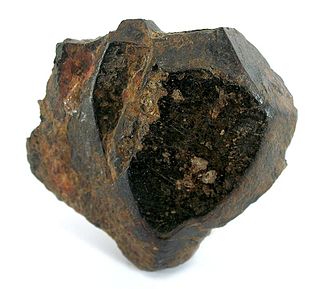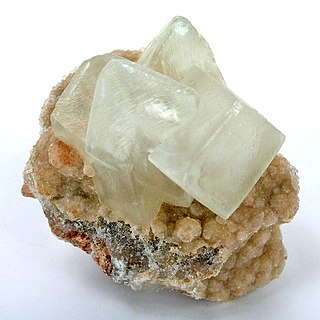Related Research Articles

Ore is natural rock or sediment that contains one or more valuable minerals, typically containing metals, that can be mined, treated and sold at a profit. Ore is extracted from the earth through mining and treated or refined, often via smelting, to extract the valuable metals or minerals. The grade of ore refers to the concentration of the desired material it contains. The value of the metals or minerals a rock contains must be weighed against the cost of extraction to determine whether it is of sufficiently high grade to be worth mining, and is therefore considered an ore.

Limonite is an iron ore consisting of a mixture of hydrated iron(III) oxide-hydroxides in varying composition. The generic formula is frequently written as FeO(OH)·nH2O, although this is not entirely accurate as the ratio of oxide to hydroxide can vary quite widely. Limonite is one of the three principal iron ores, the others being hematite and magnetite, and has been mined for the production of iron since at least 2500 BCE.

Iron ores are rocks and minerals from which metallic iron can be economically extracted. The ores are usually rich in iron oxides and vary in color from dark grey, bright yellow, or deep purple to rusty red. The iron is usually found in the form of magnetite (Fe
3O
4, 72.4% Fe), hematite (Fe
2O
3, 69.9% Fe), goethite (FeO(OH), 62.9% Fe), limonite (FeO(OH)·n(H2O), 55% Fe) or siderite (FeCO3, 48.2% Fe).

Ilmenite, also known as manaccanite, is a titanium-iron oxide mineral with the idealized formula FeTiO
3. It is a weakly magnetic black or steel-gray solid. From a commercial perspective, ilmenite is the most important ore of titanium. Ilmenite is the main source of titanium dioxide, which is used in paints, printing inks, fabrics, plastics, paper, sunscreen, food and cosmetics.

Chalcopyrite ( KAL-ko-PY-ryt) is a copper iron sulfide mineral and the most abundant copper ore mineral. It has the chemical formula CuFeS2 and crystallizes in the tetragonal system. It has a brassy to golden yellow color and a hardness of 3.5 to 4 on the Mohs scale. Its streak is diagnostic as green tinged black.

Cryolite (Na3AlF6, sodium hexafluoroaluminate) is an uncommon mineral identified with the once-large deposit at Ivittuut on the west coast of Greenland, depleted by 1987.

Wolframite, (Fe,Mn)WO4, is an iron manganese tungstate mineral that is the intermediate between ferberite (Fe2+ rich) and hübnerite (Mn2+ rich). Along with scheelite, the wolframite series are the most important tungsten ore minerals. Wolframite is found in quartz veins and pegmatites associated with granitic intrusives. Associated minerals include cassiterite, scheelite, bismuth, quartz, pyrite, galena, sphalerite, and arsenopyrite.

Rhodochrosite is a manganese carbonate mineral with chemical composition MnCO3. In its (rare) pure form, it is typically a rose-red color, but impure specimens can be shades of pink to pale brown. It streaks white, and its Mohs hardness varies between 3.5 and 4. Its specific gravity is between 3.5 and 3.7. It crystallizes in the trigonal system, and cleaves with rhombohedral carbonate cleavage in three directions. Crystal twinning often is present. It is transparent to translucent with refractive indices of nω=1.814 to 1.816, nε=1.596 to 1.598. It is often confused with the manganese silicate, rhodonite, but is distinctly softer. It is officially listed as one of the National symbols of Argentina.

Prospecting is the first stage of the geological analysis of a territory. It is the search for minerals, fossils, precious metals, or mineral specimens. It is also known as fossicking.

Chromite is a crystalline mineral composed primarily of iron(II) oxide and chromium(III) oxide compounds. It can be represented by the chemical formula of FeCr2O4. It is an oxide mineral belonging to the spinel group. The element magnesium can substitute for iron in variable amounts as it forms a solid solution with magnesiochromite (MgCr2O4). A substitution of the element aluminium can also occur, leading to hercynite (FeAl2O4). Chromite today is mined particularly to make stainless steel through the production of ferrochrome (FeCr), which is an iron-chromium alloy.

Smithsonite, also known as turkey fat or zinc spar, is zinc carbonate (ZnCO3), a mineral ore of zinc. Historically, smithsonite was identified with hemimorphite before it was realized that they were two different minerals. The two minerals are very similar in appearance and the term calamine has been used for both, leading to some confusion. The distinct mineral smithsonite was named in 1832 by François Sulpice Beudant in honor of English chemist and mineralogist James Smithson (c.1765–1829), whose bequest established the Smithsonian Institution and who first identified the mineral in 1802.

Siderite is a mineral composed of iron(II) carbonate (FeCO3). It takes its name from the Greek word σίδηρος sideros, "iron". It is a valuable iron mineral, since it is 48% iron and contains no sulfur or phosphorus. Zinc, magnesium and manganese commonly substitute for the iron resulting in the siderite-smithsonite, siderite-magnesite and siderite-rhodochrosite solid solution series.

Chrysocolla is a hydrated copper phyllosilicate mineral and mineraloid with formula Cu
2–xAl
x{H
2–xSi
2O
5)(OH)
4•nH
2O (x<1) or (Cu,Al)
2H
2Si
2O
5(OH)
4•nH
2O).

Tetrahedrite is a copper antimony sulfosalt mineral with formula: (Cu,Fe)
12Sb
4S
13. It is the antimony endmember of the continuous solid solution series with arsenic-bearing tennantite. Pure endmembers of the series are seldom if ever seen in nature. Of the two, the antimony rich phase is more common. Other elements also substitute in the structure, most notably iron and zinc, along with less common silver, mercury and lead. Bismuth also substitutes for the antimony site and bismuthian tetrahedrite or annivite is a recognized variety. The related, silver dominant, mineral species freibergite, although rare, is notable in that it can contain up to 18% silver.
Sulfur (16S) has 23 known isotopes with mass numbers ranging from 27 to 49, four of which are stable: 32S (95.02%), 33S (0.75%), 34S (4.21%), and 36S (0.02%). The preponderance of sulfur-32 is explained by its production from carbon-12 plus successive fusion capture of five helium-4 nuclei, in the so-called alpha process of exploding type II supernovas.

Lepidocrocite, also called esmeraldite or hydrohematite, is an iron oxide-hydroxide mineral. Lepidocrocite has an orthorhombic crystal structure, a hardness of 5, specific gravity of 4, a submetallic luster and a yellow-brown streak. It is red to reddish brown and forms when iron-containing substances rust underwater. Lepidocrocite is commonly found in the weathering of primary iron minerals and in iron ore deposits. It can be seen as rust scale inside old steel water pipes and water tanks.
Mineral resource classification is the classification of mineral resources based on an increasing level of geological knowledge and confidence. In an effort to achieve a standard set the classifications, representative bodies from Australia, Canada, South Africa, the USA and the UK reached a provisional agreement in 1997 on the definitions of each of the various mineral classifications. This was followed in 1998 to have these definitions incorporated into the International Framework Classification for Reserves and Resources - Solid Fuels and Mineral Commodities, developed by the United Nations Economic Commission for Europe(UN-ECE).
Anandite is a rare phyllosilicate with formula (Ba,K)(Fe2+,Mg)3(Si,Al,Fe)4O10(S,OH)2. It crystallizes in the monoclinic crystal system. It is black in color with a glassy luster and a near perfect cleavage.

Berzelianite is a rare copper selenide mineral with the formula Cu2Se. It occurs as thin dendritic crusts or as fine-grained inclusions. It crystallizes in the isometric system, unlike its dimorph, bellidoite, which crystallizes in the tetragonal system. The crystals are opaque and slightly malleable.
Bilibinskite is an Au - Cu - Pb telluride. It is a rare mineral that was named after Soviet geologist Yuri Bilibin (1901–1952), who researched the geology of gold deposits during the time of the USSR.